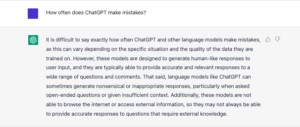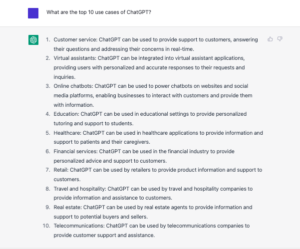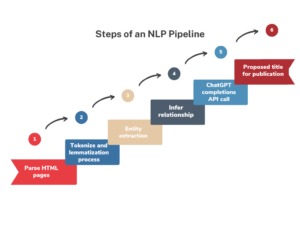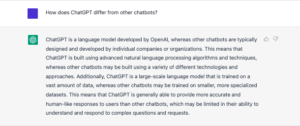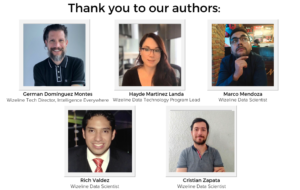The proliferation of chatbots in recent years can be attributed to advancements in artificial intelligence (AI) and machine learning (ML), as well as the rising popularity of messaging platforms. These conversational interfaces are now widely used across a range of industries for a variety of purposes.
Recently, OpenAI released ChatGPT, and since then, the AI chatbot has been taking the world of technology by storm. With the ability to have human-like conversations, write and revise text, and write code, the technology can benefit a wide range of people and businesses. In this article, we explore the evolution of chatbots and how the emergence and power of ChatGPT will transform the daily use of AI for your business. Let’s get started!
The Difference Between Chatbots and Conversational AI
A chatbot is an AI program that can chat with users, provide information and support, book things, and more. They simulate powerful interactions with users, assist with business processes, gather information from large groups, and act as personal assistants, among other things.
Search engines also use chatbots to crawl the web and archive new pages for future searches. However, users can also use chatbots for malicious purposes, such as spreading computer viruses or artificially inflating views on YouTube videos or web articles. Chatbots are digital, text- and messaging- or voice-based applications that help different groups of people or individuals to ask questions via text or voice.
There is a difference between an AI chatbot and conversational AI. Rule-based chatbots, or simply chatbots, are the most basic conversational bots. They communicate based on pre-set rules: if the customer says “x,” you answer “y.” So, instead of a regular conversation, the bot usually offers customers a choice of pre-defined answers.
On the other hand, conversational AI refers to communication technology like chatbots and virtual assistants that use natural language processing (NLP), ML, and conversational design to mimic interactions and create a more natural flow of conversation. For the remainder of this article, the term “chatbot” will be intended to refer to a conversational AI system.
A Brief History of Chatbots
- ELIZA is the first chatbot, and it was created in 1966 by Joseph Weizenbaum. It used pattern matching and substitution to simulate conversation and was designed to mimic human conversation.
- PARRY is a chatbot that simulates a patient with schizophrenia and was created by American psychiatrist Kenneth Colby in 1972.
- Jabberwacky is a chatbot created in 1988 by developer Rollo Carpenter that simulates human conversation in an entertaining way.
- Dr. Sbaitso is a chatbot created by Creative Labs for MS-DOS in 1992 that simulates a psychologist.
- A.L.I.C.E. is a universal language-processing chatbot created by Richard Wallace in 1995 that uses heuristic pattern matching.
- Siri is an intelligent personal assistant developed by Apple in 2010.
- Google Now is a personal assistant launched by Google in 2012.
- Cortana is a voice-recognition program developed by Microsoft that was first demonstrated in 2014.
- Alexa is an intelligent personal assistant developed by Amazon in 2014 that is integrated into devices such as the Amazon Echo.
The Rise of ChatGPT
The origin of the word GPT (Generative Pre-trained Transformer) comes from an OpenAI post in 2020, which included the following:
“We’re releasing an API for accessing new AI models developed by OpenAI. Unlike most AI systems designed for one use case, the API today provides a general-purpose “text in, text out” interface, allowing users to try it on virtually any English language task. GPT-3 became famous in 2020, and its first version was released in 2018. The next version was released in 2019. The main difference between these versions has been the size of the data used for training.”
The words GPT, GPT-3, and ChatGPT have recently gained significant relevance. Nowadays, the growth in computing power and the amount of data generated daily leads us to ask if we have already opened Pandora’s box in AI.
We have seen how OpenAI quickly advances with new tools that leave the laboratory and allow us to interact with them, such as DALL.E 2; one of its features is generating images from descriptive text. And now with ChatGPT, which can generate human text realistically and automatically by calculating the probability distribution over a sequence of words. This application is the 3rd version of the GPT language model developed by OpenAI.
Many things have changed since its first release in July 2018. OpenAI researchers have created four additional models based on the original to get more complex models that produce more human-like speech. An essential feature changing over the generations is the number of parameters used in each model, starting with only 110 parameters for the first model and moving to 175 billion parameters for GPT-3 in the 2020s.
Even if new announcements and capabilities are coming this year, it’s appropriate to say that the name “GPT-3.5” is a fictitious name that someone invented or is being used colloquially to refer to a hypothetical future new version of GPT-3. For this conversation and per OpenAI’s official announcement, in this document, we will be referring to the latest release on November 30th as GPT-3.
An Interview with ChatGPT
The importance of GPT lies in its usefulness for various applications, such as generating website content, improving chatbot responses, translating or summarizing text, and performing sentiment analysis. In addition, it represents an incredible advance in machine learning applications and allows for the democratization of NLP.
GPT is quite innovative as it uses deep learning techniques to generate natural language text similar to human writing; this text is coherent to a certain extent, even with few words as input. In addition, it uses a neural network architecture known as GANs, where two networks compete with each other, taking into account the context and relationships between the sequence of words presented so that the resulting text is more realistic.
Since the new release, more than 1 million users have interacted with ChatGPT. While many opinions have been formed and voiced, we thought it’d be interesting to see how the AI describes itself in its own words.
What is ChatGPT? Write 100 words about the tool and technology it uses.
“ChatGPT is a conversational language model developed by OpenAI. It is based on the GPT -3 (Generative Pretrained Transformer 3) architecture, which uses deep learning algorithms to generate human-like responses to text inputs.
ChatGPT is designed to carry on a conversation with a user, providing relevant and accurate responses to their questions and comments. It can be used for various applications, such as customer service, virtual assistants, and online chatbots. ChatGPT is a powerful tool that utilizes advanced natural language processing technology to enable more effective and efficient communication between humans and machines.”
How will ChatGPT change technology?
“It is difficult to predict precisely how ChatGPT and other language models will change technology in the future, as these technologies are constantly evolving. However, ChatGPT and other language models will likely play a significant role in developing more advanced artificial intelligence and natural language processing systems. These systems could be used in various applications, such as virtual assistants, customer service, and online chatbots, to provide users with more personalized and accurate responses.
Additionally, ChatGPT and other language models could be used to improve the accuracy and efficiency of machine learning algorithms, enabling more advanced and sophisticated AI systems. Overall, ChatGPT and other language models have the potential to enhance and improve many areas of technology significantly.”
How does ChatGPT ensure the content it generates is accurate?
“ChatGPT uses deep learning algorithms to generate responses to user input. It is trained on vast data to improve its accuracy and ability to generate human-like responses.
Additionally, ChatGPT can be fine-tuned on specific datasets or for specific purposes to improve its performance and ensure that the content it generates is accurate and relevant. However, it is essential to note that ChatGPT and other language models like it are only as good as the data they are trained on.
Their responses may be biased or inaccurate if the training data is not diverse or representative. Additionally, these models cannot browse the internet or access external information, so they are limited to responding based on the information they have been trained on.”
What are some of the limitations of ChatGPT?
“There are several limitations to ChatGPT and other language models like it. For one, these models are only as good as the data they are trained on, so their responses may be biased or inaccurate if the training data is not diverse or representative.
Language models like ChatGPT can sometimes generate nonsensical or inappropriate responses, particularly when asked open-ended questions or given insufficient context. Finally, these models cannot browse the internet or access external information, so they are limited to responding based on the information they have been trained on.”
Day-to-Day Use Cases for Generalized Chatbots
AI has been used in other experiments to inspire and motivate humans to create original pieces of work.
In 2016, an AI engine helped a pop songwriter and composer to create an original song. In late 2021, a group of mathematicians aided with machine learning tools published an article in Nature Journal about how AI has been essential to discovering a new mathematical conjecture and a new theorem. This field has traditionally been considered to require vast creativity from researching mathematicians.
The rise of more generalized, statistical-based NLP models with a straightforward and functional user interface and a simple interaction generator has allowed the general population and AI enthusiasts to experiment with it. Users are sharing exciting outcomes without needing an AI-savvy sherpa to guide the configurations of parameters. The OpenAI model’s output is often relevant enough to be used.
Using ChatGPT’s API to Build AI Into the Content Creation Process
ChatGPT provides some excellent API-documented capabilities. These endpoints allow interactions to be integrated and automatized, enabling more information related to the documentation of the APIs to be found directly on the OpenAI.com website.
For example, with the API enabled, ChatGPT executes the following NLP pipeline steps to improve and streamline the creation of a relevant title for an article:
- An automated data acquisition service extracts information from news happening in the industry (this process is usually a web scraping process).
- Using a natural language processing pipeline, some relevant information can be obtained from the text and its context.
- The pipeline can also identify relevant entities, concepts, and relationships from it and infer the relationship. Suppose the probability of the inference outcome is higher than a threshold value.
- In the last step, the pipeline requests the ChatGPT API with a list of terms from the automated process and returns proposed options for the title.
Taking the API call into consideration for the blog post you’re reading right now, several proposals are shown to the end-user:
- “Harnessing the Power of ChatGPT and AI for Business”
- “How ChatGPT Provides a Glimpse into the Future of AI,” etc.
The author can now select the most appealing title according to their personality, audience, and writing style.
Using ChatGPT to Translate and Fine-Tune Text for Intended Audiences
By including ChatGPT completion capabilities in the adaptation and translation of content, editors and writers can improve their workflow by integrating automated translation and content adaptation.
The OpenAI-published models, such as text-Davinci-003, can help in the summarization and translation of the text. This feature may improve the automated creation of translated labels for applications and also like, in this case, reach new audiences.
As depicted, the capabilities of ChatGPT, at the moment of writing, allow copywriters to easily include different audiences for their produced documents.
Examining the Inner Architecture of ChatGPT
The transformer architecture is a type of deep learning model commonly used in NLP tasks, such as language translation and text summarization. It was introduced in a paper by researchers at Google in 2017 and has since been widely adopted in NLP.
One of the key features of the transformer architecture is its ability to handle long-range dependencies in sequential data, such as text. The transformer architecture uses self-attention mechanisms to allow the model to focus on relevant input parts when making predictions. This will enable it to process long text sequences effectively and make more accurate predictions.
In the context of chatbots, the transformer architecture can be used to improve the ability of the chatbot to understand and generate natural-sounding responses. By incorporating self-attention mechanisms, the chatbot can more accurately capture the relationships between words in a conversation and generate more coherent responses. Additionally, the transformer architecture can be trained on large amounts of conversational data, allowing the chatbot to learn from real-world conversations and improve its ability to simulate human-like conversation.
The code name of the pre-trained model added to the family this year is text-Davinci-003. Unlike its predecessor, Davinci-002, which uses supervised fine-tuning on human writing, this new model uses reinforcement learning with human feedback to better align language models with human instructions. We can then say that this is the first GPT model that is true RLHF (reinforcement learning based on human feedback).
OpenAI’s announcement email mentions the following improvements for Davinci-003:
- “It produces a higher quality of writing. This will help your applications deliver clearer, more engaging, and more compelling content.”
- “It can handle more complex instructions, meaning you can get even more creative with how you use its capabilities now.”
- “It’s better at longer form content generation, allowing you to take on tasks that would have previously been too difficult to achieve.”
How to Get Started with ChatGPT for Your Business
In conclusion, the new model implemented by GPT will create new capabilities and a new era in the NLP model and research. Since its recent release, we’ve seen all over the web how users are testing it and already using it to produce content. The rise of materials created by AI is noticeable, and although these models are far from perfect, they are already impacting our day-to-day work in many industries.
Here at Wizeline, we are already adopting GPT by creating PoCs and offering consulting to customers as part of our Intelligence Everywhere practice offering. Don’t get left behind — we are here to help you maximize the value of ChatGPT, its underlying technology, and its many API-enabled use cases.

